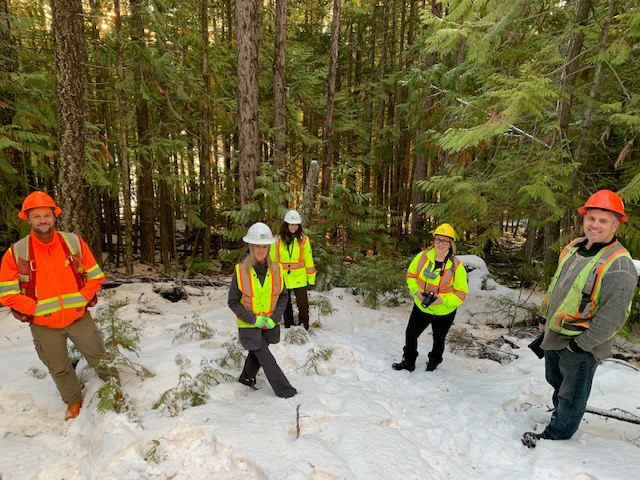Okanagan, B.C.: Last summer, four water purveyors – or municipal/regional water utility providers – in the Okanagan were awarded grants from the Forest Enhancement Society of BC totaling $678,910. The purpose of the grants was to fund a collaborative approach to wildfire risk reduction in all four major Okanagan watersheds.
The work happening on the ground now will not only safeguard high priority interface areas of the individual watersheds which border one another, but also help protect the broader Okanagan basin’s water quality, important wildlife habitat and infrastructure, and create opportunities to enhance the utilization of woody fibre associated with interface fuel management treatment.
Frontline Operations Group Ltd.’s Principal, John Davies, RPF, is heading up the projects. He’s been working with all four water purveyors together with input from First Nations, local governments, and key stakeholders to lead the development of prescriptions for high-value watershed infrastructure sites and a landscape level wildfire risk management plan to identify high-risk areas and subsequent plans to reduce dangerous wildfire behaviour. He is pleased with the level of engagement from all the water purveyors in the planning and the work now being done for the projects.
“The four water purveyors for the watersheds on the Aberdeen Plateau have collaboratively developed maps illustrating opportunities for landscape level fuel break development extending across the watersheds from Lavington to Joe Rich,” says Davies. “The locations are conceptual and based on in-depth GIS analysis and additional input from BC Wildfire Service (BCWS).”
A fuel break is an area where flammable woody material is removed in order to slow or stop a wildfire.
The four water purveyors involved have all started the hands-on work:
- District of Lake Country,
- Regional District of North Okanagan,
- Glenmore-Ellison Improvement District, and
- Black Mountain Irrigation District
“All four water purveyors have small-scale operational projects on the go over the fall and winter. Work will occur around residential developments as well as critical infrastructure associated with water intakes, treatment facilities, and communication towers essential to safe operations of the watersheds. Plus, these projects are providing opportunities for local contractors to pick up additional work.”
John Davies, RPF, Frontline Operations Group Ltd.
Here is a status report on each of the projects:
District of Lake Country Project: work has seen the removal of woody debris from approximately 2.5 hectares in an area near the Beaver Lake Lodge and the Vernon Creek intake. The Beaver Lake Reservoir provides essential water services for over 4,000 customers and is a backup for Okanagan Lake water customers. The wood being removed is fallen dead wood which has been provided as firewood for the local community and delivered to Okanagan Indian Band for their elders.
Black Mountain Irrigation District: A treatment to thin and remove trees for the Philpott Road has been prescribed and the Irrigation District is working with Gorman Bros. Lumber to finalize the implementation of the project this winter. Mapping of the area and recommended treatments are complete on four fuel break areas above Schram Creek slope.
Glenmore Ellison Improvement District: The Postill Lake project area will see work begin shortly as site conditions permit. An additional area has also been prescribed for treatment outside of the Postill Lake area and has been sent to the Ministry of Forests, Lands, Natural Resource Operations and Rural Development, and BCWS for assistance.
Regional District of North Okanagan: The removal of trees and ground debris through hand and machine treatments is underway in an area near the Bluenose Trail in Lavington and behind private residences along Bluenose Road. The work will serve to reduce wildfire risk for homes and key infrastructure for the Greater Vernon Water Utility. Timber harvested by local contractors will go to local mills and any merchantable timber will go to local processing facilities. In addition, traditional Indigenous fire practices will be incorporated in understory cleanup.
Also pleased with the planning and implementation is Dave Conly, RPF, Operations Manager for FESBC.
“When we are assessing projects to fund, not only do they need to align with our purposes, but we appreciate it when they are proactive and collaborative, and these four projects checked all the boxes,” said Conly. “We continue to monitor progress and are engaging in a number of field trips with the contractors and water purveyors. We look forward to completing this first phase of work to reduce fire behaviour and severity.”
All four FESBC-funded projects are expected to be complete by late summer 2021.
“The watersheds provide water to many communities, and tens of thousands of residents, throughout the North and Central Okanagan. To have the water quality and quantity within these watersheds impacted to any degree by a wildfire would cause incredible duress to communities and residents alike.”
John Davies, RPF, Frontline Operations Group Ltd.

